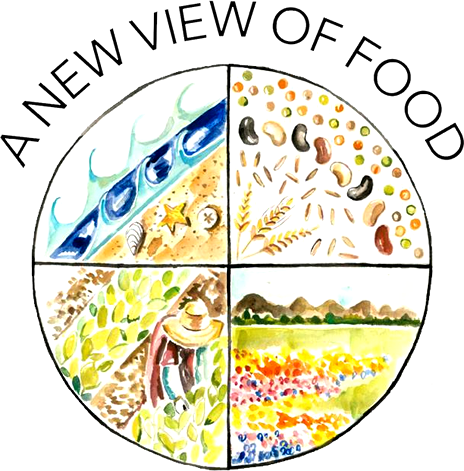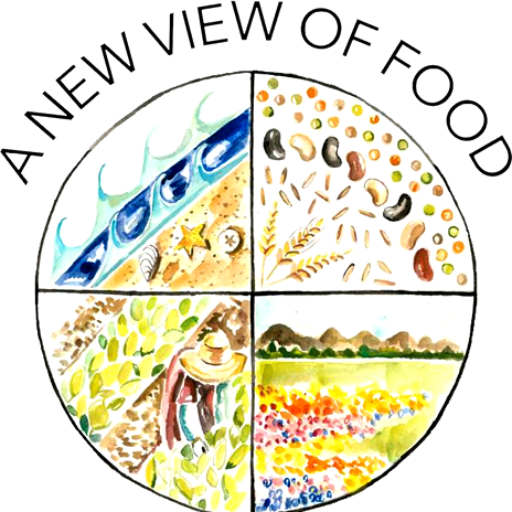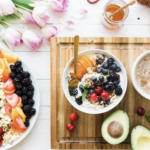Happy February, 2022! What a brief but mighty month!
This month we celebrate Black History, Heart Health, Valentine’s Day and the Lunar New Year, among many other lesser known observances. At the intersection of all of these I see love and hope and resilience.
When you power your cells with the energy of plants, your body will run more efficiently and your mind will experience more clarity. It’s like running a powerful V-8 engine with highest quality fuel; It would be a mistake to use anything else.
Are you ready to start feeding your heart, bathing in self-love, and experiencing your own renewal? Here are your 10 steps to ensure success:
Step 1. Eat the Rainbow of colors every day, plus black and white foods, too.
- Learn to recognize whole plant foods, and distinguish them from their more processed forms. A whole plant food is in its natural state, cell walls are intact, nothing is added and nothing taken away.
- There are 4 main food groups: Vegetables, fruits, whole grains and legumes (beans, peas, split peas, lentils, chickpeas). Nuts and seeds can be considered fruit as well. Most of us know that the peanut, that comes in a pod, is actually a legume. Herbs and spices are definitely plants, and extremely rich sources of health promoting phytonutrients. And mushrooms are in a class by themselves, being a fungus! “There’s a fungus among us!” Okay, dumb joke, but mushrooms contain a unique array of myconutrients that also help us thrive. Sea vegetables, like nori, wakame, and arame seaweed, are also unique in their mineral content, giving us important iodine for our thyroid to function well. Many folks don’t have access to sea vegetables regularly, so iodized salt was introduced. ½ teaspoon of iodized salt contains a day’s worth of iodine (150 mcg).
- Can you think of at least one commonly eaten plant for each color of the rainbow (ROYGBIV)? I’ll spot you a couple in the black and white categories: Black rice, black beluga lentils, button mushrooms and quinoa.
Step 2. Go shopping and buy more whole plants to eat.
- Some of you can also start growing some of your own vegetables and herbs, or plant a fruit tree. Many folks don’t have the space or the inclination, so they rely of stores and farmers markets, and even CSA (community sponsored agriculture) boxes to be delivered. Where do you like to shop and can you find whole plant foods at these places? Do you need to think outside the box and find more ways to fill your pantry and your refrigerator?
- Avoid buying more processed food. A coconut is a fruit, but coconut oil is a processed food, and can be a concerning source of saturated fat. Sugar cane is a whole plant, but granulated white sugar is definitely processed, and should be minimized. Soybeans are whole plants; they are minimally processed into common foods like soy milk, tofu and tempeh. Unlike refined oils and sugar, these soy products still retain a lot of their original nutritive value.
- Learn how to cook and eat these new foods. You might need a pressure cooker or Instant Pot to help cook your new grains and legumes. You might want to invest in a high-speed blender to help make delicious smooth soups and sauces. These aren’t essential, but investing in some clean cooking cookware definitely is. Please discard any old and scratched Teflon pans. Here is a source to help you find your safest options. https://www.mamavation.com
Step 3. Find a few plant strong recipes for each meal you like to eat, including snacks (if you are a snacker)
- Here are a few examples of where to look on line, and for any books by these authors, too: Julieanna Hever, RD (The PlantBasedDietitician), Clean Food Dirty Girl, Engine 2, How Not to Die and How Not to Diet Cookbooks by Dr. Michael Greger; Anything by Dr. Caldwell Esselstyn, Jr., The Physicians Committee for Responsible Medicine and Dr. Neal Barnard, The Plantrician Project, T. Colin Campbell’s Center for Nutrition Studies, Kim Campbell, Dreena Burton, Forks Over Knives, John and Ocean Robbins and Brenda Davis, RD. And there are many, many more recipes on line. Whatever you want to eat, just Google, “Best vegan ____ recipe” and you will have options at your fingertips instantly!
Step 4. Think about how to add more plants to your day!
- I add a tablespoon or two of ground flax, various fruit/berries (ex. blueberries, raspberries, blackberries, mulberries, dried cherries, bananas, raisins), and spices (ex: vanilla, Ceylon cinnamon, nutmeg, AMLA powder and even turmeric), to my steel cut oats or whole oat groats. I eat my vegan stew or stir-fried vegetables and tofu (or any warmed leftovers) on a bed of fresh or steamed greens. I snack on fresh organic apples, and indulge in medjool dates stuffed with walnuts, or almond butter. The next time you sit down to eat, think about what you might do to add some plant powered punch to your meal.
Step 5. Take your vitamin B12 and D
- These are essential nutrients, but they don’t reliably come from plants or animals. Animals raised for our food are supplemented with B12 (critical for a functioning nervous system), which is actually made by bacteria. We make Vitamin D in our skin in response to sunlight. If you have been blessed with darker skin, protecting you from the harmful UV rays from our sun, you may, unfortunately, also be more at risk of vitamin D deficiency. If you are overweight or obese, low Vitamin D will also be a problem. You may opt to have your blood levels of B12 and Vitamin D checked to be sure you are not at risk of any issues related to chronically low levels. I recommend a Methylmalonic Acid test as the best functional B12 test (a lower level of MMA is good). A 25, OH-Vit D test is the best test for your blood level of Vitamin D, which is so important for our immune system and our bones.
Step 6. Expand your knowledge of plant based diets and the role animal agriculture plays in our sustainability issues.
- Easy to find films such as Forks Over Knives, Cowspiracy, Seaspiracy, What the Health, The Game Changers Movie, and the short YouTube film that inspired me to be vegan: What Came Before, by Farm Sanctuary, narrated by Steve-O. If you are a person of religious faith, you may like A Prayer for Compassion, produced by the inspiring Victoria Moran.
Step 7. Add a few more recipes to your repertoire.
- One Green Planet has 1000’s of recipes.
- Try a new vegetable, a new grain, a new legume. I tried dragonfruit this year and loved it! I had never tasted it before.
- Jerusalem artichokes, for example, or sunchokes, rich in inulin, a wonderful fiber for your gut microbiota, may be hiding out in the shelves of your favorite well stocked market
- Kabocha squashes, purple yams, hen of the woods ‘shrooms…the variety of edible plants in our Garden of Eden is almost limitless. Take advantage!
Step 8. Make something to share with your neighbor, your coworkers, your friends.
- Food is an important part of the social contract we have with other humans.
- Like breaking bread together, when you create delicious food to share, you invite a safe and delicious intimacy with others.
- Just be aware of any food intolerances or true allergies before you present your edible creation to your friends.
Step 9. Extra credit for optimizing health: Become aware of and minimize saturated fat and sodium in the foods you buy and make.
- Many recipes will call for oil and salt, find alternatives for baking or leave it out.
- Many frozen or canned whole plant foods may come already with added salt or oil. Even some dried fruit may be dipped in oil (I am sensitive to the rancid taste/smell).
- Start looking at the nutrition label on foods you buy that are not simply produce, fresh or dried grains and legumes; you may be surprised.
- Humans don’t require saturated fat (solid at room temperature) to thrive
- We get enough sodium from whole plant foods, and we rarely need to put extra salt in our food.
- Sodium is a major contributor to hypertension, which is the number one cause of heart attacks, our number one killer.
- You can find low sodium alternatives, and even Benson’s No Salt, and a fermented soy bean paste called Miso, that tastes salty but does not contribute to high blood pressure. Thank you, soy!
- Looking for a coconut taste without the LDL-cholesterol raising saturated fat of coconut milk? Try coconut extract and your favorite plant milk.
- Some times are just the right times to indulge. We all do: Birthdays, holidays, when traveling…
- I keep two things in mind and this helps me weigh the risks and benefits: Dr. Klaper says, “Your arteries are never not looking.” And I’m not sure who said this, I think all the experts agree: “It’s not what you eat once in a while, it’s what you eat most of the time that really matters.”
- So, try to eat lots of healthy plant foods most of the time!
Step 10. Do a little happy dance in your kitchen! You’ve invested time and energy in the most important form of self-love, ensuring that you live a long, happy, and healthy life! The entire planet will rejoice with you! Can’t you just feel it?
If this sounds a little too challenging to do all on your own, why don’t we have a conversation? Check for a mutually agreeable time on my<a href=”http://www.calendly.com/debrashapiro1″ > calendar and we can chat about how one-on-one health coaching might be just the kind of support you need to thrive.
And, if you are planning to get pregnant in 2022, check out our group program developed specifically for you and your spouse: www.pregnancyadvantage.net.
Whatever month or year we are in, I’m always celebrating what’s possible for folks who can learn to love themselves so radically, that they try every day to nourish their bodies with colorful, fiber rich whole plant foods. Anyone else on board with this? It’s really not just our game, here; the health of our entire planet depends on most of us humans making this major shift.
It’s not hard; It’s just food!
Be safe and well,
(and eat lots of plants!
Debra







